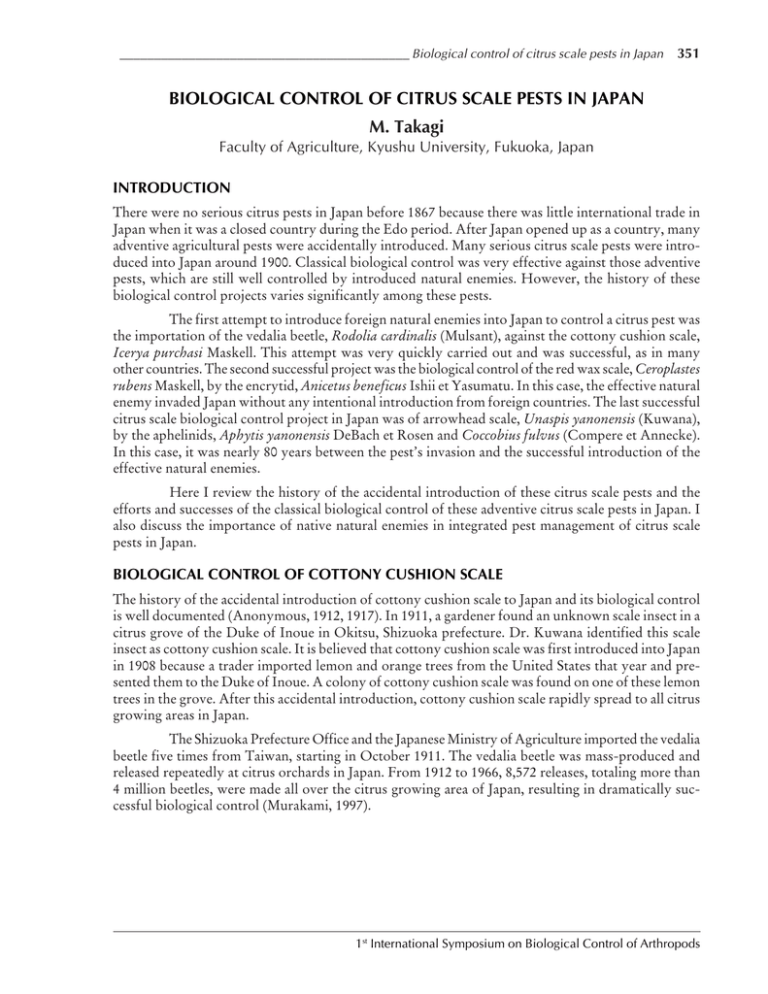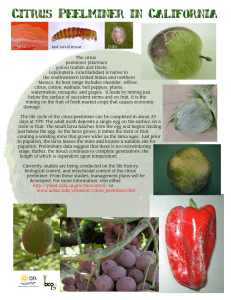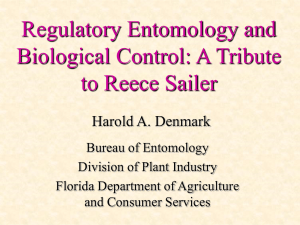BIOLOGICAL CONTROL OF CITRUS SCALE PESTS IN JAPAN M. Takagi INTRODUCTION
advertisement

__________________________________________ Biological control of citrus scale pests in Japan 351 BIOLOGICAL CONTROL OF CITRUS SCALE PESTS IN JAPAN M. Takagi Faculty of Agriculture, Kyushu University, Fukuoka, Japan INTRODUCTION There were no serious citrus pests in Japan before 1867 because there was little international trade in Japan when it was a closed country during the Edo period. After Japan opened up as a country, many adventive agricultural pests were accidentally introduced. Many serious citrus scale pests were introduced into Japan around 1900. Classical biological control was very effective against those adventive pests, which are still well controlled by introduced natural enemies. However, the history of these biological control projects varies significantly among these pests. The first attempt to introduce foreign natural enemies into Japan to control a citrus pest was the importation of the vedalia beetle, Rodolia cardinalis (Mulsant), against the cottony cushion scale, Icerya purchasi Maskell. This attempt was very quickly carried out and was successful, as in many other countries. The second successful project was the biological control of the red wax scale, Ceroplastes rubens Maskell, by the encrytid, Anicetus beneficus Ishii et Yasumatu. In this case, the effective natural enemy invaded Japan without any intentional introduction from foreign countries. The last successful citrus scale biological control project in Japan was of arrowhead scale, Unaspis yanonensis (Kuwana), by the aphelinids, Aphytis yanonensis DeBach et Rosen and Coccobius fulvus (Compere et Annecke). In this case, it was nearly 80 years between the pest’s invasion and the successful introduction of the effective natural enemies. Here I review the history of the accidental introduction of these citrus scale pests and the efforts and successes of the classical biological control of these adventive citrus scale pests in Japan. I also discuss the importance of native natural enemies in integrated pest management of citrus scale pests in Japan. BIOLOGICAL CONTROL OF COTTONY CUSHION SCALE The history of the accidental introduction of cottony cushion scale to Japan and its biological control is well documented (Anonymous, 1912, 1917). In 1911, a gardener found an unknown scale insect in a citrus grove of the Duke of Inoue in Okitsu, Shizuoka prefecture. Dr. Kuwana identified this scale insect as cottony cushion scale. It is believed that cottony cushion scale was first introduced into Japan in 1908 because a trader imported lemon and orange trees from the United States that year and presented them to the Duke of Inoue. A colony of cottony cushion scale was found on one of these lemon trees in the grove. After this accidental introduction, cottony cushion scale rapidly spread to all citrus growing areas in Japan. The Shizuoka Prefecture Office and the Japanese Ministry of Agriculture imported the vedalia beetle five times from Taiwan, starting in October 1911. The vedalia beetle was mass-produced and released repeatedly at citrus orchards in Japan. From 1912 to 1966, 8,572 releases, totaling more than 4 million beetles, were made all over the citrus growing area of Japan, resulting in dramatically successful biological control (Murakami, 1997). 1st International Symposium on Biological Control of Arthropods 352 Takagi _________________________________________________________________________________ BIOLOGICAL CONTROL OF RED WAX SCALE The second successful case of citrus scale biological control in Japan was of the red wax scale, C. rubens, by A. beneficus. In 1897, red wax scale was found in and around Nagasaki city (Kuwana, 1923). It was accidentally introduced probably from China before 1880. The host range of red wax scale is very wide, including more than 130 plant species (Ohgushi, 1969). Some of the host plants are ornamental trees and some others are economically important plants such as citrus, tea, and persimmon. Thus red wax scale was one of the most serious citrus pests before the successful use of biological control by introducing A. beneficus. Several native natural enemies attacked red wax scale, but were not effective. Dr. Ishii suggested the need to introduce foreign natural enemies (Ishii, 1923). Several foreign natural enemies, such as Scutellista cyanea Motschulsky, Moranila California (Howard), Aneristus ceroplastae Howard, and Microterys kotinskyi (Fullaway) were introduced (Murakami, 1997), but all of those attempts failed (Yasumatsu and Tachikawa, 1949). Finally Dr. Yasumtsu discovered a new species of parasitoid (later known as A. beneficus) of red wax scale on a laurel tree at the campus of Kyushu University in 1946. He shipped this parasitoid to citrus growing areas of Japan where this parasitoid had not distributed yet. This attempt was very successful. Dr. Yasumtsu believed that this parasitoid might have evolved from Anicetus ceroplastis Ishii by mutation around 1942 (Yasumatsu, 1958, 1969). However, this parasitoid (A. beneficus) was later found to be a species native to central and southern China (Tachikawa, 1985). It is now believed that this parasitoid was accidentally introduced from China into Japan in the 1920s (Murakami, 1997). This case of successful biological control appears to be a fortuitous accidental introduction of the beneficial insect. Hirose et al. (1986) detected a strong aggregative response by A. beneficus to high density patches of red wax scale, but found that the resultant pattern of parasitism was density independent. From this finding they suggested that the parasitoid’s response to the patterns of host spatial density did not automatically induce pest population stability. They suggested that the spatial density of the natural enemy was not the key to pest regulation, but rather it was the parasitoid’s temporal density dependence that was responsible. BIOLOGICAL CONTROL OF ARROWHEAD SCALE In 1907, several citrus trees died because of serious outbreak of an unknown species of scale insect at an orchard on a small island in Ikiriki, in Nagasaki prefecture. This scale insect had been observed in Nagasaki city several years before this outbreak. In 1908, Dr. Kuwana visited Ikiriki to examine this scale insect and described it as a new species (Kuwana, 1923). He suggested that this insect had been accidentally introduced from China and named it “yanone-kaigaramushi” (= arrowhead scale). By 1930, arrowhead scale had spread over all of the citrus growing area of Japan (Furuhashi and Ohkubo, 1990). For a long time, this insect was one of the most serious citrus pests in Japan because there were no effective natural enemies of it in Japan until 1982. In order to control arrowhead scale, introductions of the aphelinid, Aphytis lingnanensis Compere, from Hong Kong were initially attempted, but they failed to achieve sufficient control (Watanabe, 1958; Tanaka and Inoue, 1977). More recently, Szechwan province in China was considered as an appropriate area for exploration for natural enemies of the pest. However, until 1972, diplomatic relations did not exist between China and Japan, and consequently Japanese entomologists could not search for natural enemies in China. After the restoration of diplomatic relations, a mission 1st International Symposium on Biological Control of Arthropods __________________________________________ Biological control of citrus scale pests in Japan 353 from Japan conducted a survey for natural enemies of arrowhead scale and found two aphelinids, C. fulvus and A. yanonensis, parasitizing arrowhead scale in Szechwan in 1980 (Furuhashi and Nishino, 1983). These two parasitoids were imported into Japan and released repeatedly in citrus growing areas. Fortunately, both of the parasitoids established and now provide good control of the arrowhead scale in Japan (Furuhashi and Ohkubo, 1990; Hirose and Takagi, 1992). Given information about the biological attributes of the two parasitoids (Takagi and Hirose, 1994), one may have expected the competitive displacement of C. fulvus by A. yanonensis. The latter is competitively superior to the former in cases of multiparasitism. Furthermore, the reproductive potential of A. yanonensis is higher than that of C. fulvus. On the other hand, C. fulvus has greater longevity and higher fecundity. These biological attributes of C. fulvus are favorable for the maintenance of its own population at lower levels of the host population. One might choose to introduce only C. fulvus because it seems to be a better agent at low pest population density. In the field, however, the two parasitoids coexist and play a complementary role in the biological control of the pest. Population dynamics of arrowhead scale were studied from 1982 to 1995 at a citrus grove in Fukuoka, Japan (Takagi et al., unpubl.). We released only A. yanonensis in June 1982 at the grove, but C. fulvus invaded from outside the grove in 1989. The adult female density of arrowhead scale decreased rapidly after the release of A. yanonensis, which kept the density at a low level after that. The population density of arrowhead scale decreased to an even lower level after the invasion of C. fulvus. Seasonal changes in the host density and the percentage parasitism of the two parasitoids indicated that the two parasitoids were complementary in their effects and both parasitoids together maintained the pest population at a lower level than either single species alone. CONSERVATION OF NATIVE NATURAL ENEMIES Kawai (1980) recorded 58 species of scales and mealybugs infesting citrus trees in Japan. However, few of them are serious pests. Most of these scales and mealybugs seem to be controlled by native natural enemies. Yasumatsu and Watanabe (1964) listed 83 species of parasitoids and 35 species of predacious insects from Japan associated with these citrus pests. Almost of those natural enemies are native species, many of which are polyphagous. Nohara (1970) found 16 parasitoids, 37 predators, and 66 spiders in nonsprayed citrus groves in Hagi, suggesting the importance of conservation of native natural enemies for integrated control of citrus pests. Nohara et al. (2000) reported that use of chemical pesticide sprays reduced the natural enemy fauna and induced outbreaks of spider mites. Conservation of these native natural enemies is very important for the integrated pest management of native citrus scale pests. Adventive scale pests are currently controlled by introduced natural enemies. However, Nohara (1970) recorded many species of native natural enemies attacking arrowhead scale before the introduction of A. yanonensis and C. fulvus. Some of the native generalist predators, such as Saura japonica Gorham, were active in citrus orchards where arrowhead scale is now under economic control after the introduction of the effective parasitoids (Takagi and Ogata, 1985). Even in cases where the introduction of specific parasitoids have resulted in spectacular biological control, the importance of the native generalist predators should not be ignored. To evaluate these native generalist natural enemies, more careful field studies are needed. ACKNOWLEDGMENTS I thank Prof. T. Bellows for help with the manuscript. 1st International Symposium on Biological Control of Arthropods 354 Takagi _________________________________________________________________________________ REFERENCES Anonymous. 1912. The Detailed Story of Control of the Cottony Cushion Scale. The Department of Interior of Shizuoka Prefecture, Shizuoka, Japan. (in Japanese) Anonymous. 1917. The study on the vedalia beetle and the cottony cushion scale. Byokin Gaichu Iho (Bulletin on Disease Bacteria and Insect Pests) 3: 1-107. (in Japanese) Furuhashi, K. and M. Nishino. 1983. Biological control of arrowhead scale Unaspis yanonensis, by parasitic wasps introduced from the People’s Republic of China. Entomophaga 28: 277-286. Furuhashi, K. and N. Ohkubo. 1990. Use of parasitic wasps to control the arrowhead scale, Unaspis yanonensis (Hom., Diaspididae), in Japan, pp. 71-81. In Bay-Petersen, J. (ed.). The Use of Natural Enemies to Control Agricultural Pests. Food and Fertilizer Technology Center for the Asian and Pacific Region, Taipei, Taiwan. Hirose, Y. and M. Takagi. 1992. Biological control of insect pests and weeds in Japan: current problems and future prospects, pp. 23-34. In Hirose, Y. (ed.). Biological Control in South and East Asia. Kyushu University Press, Fukuoka, Japan. Hirose, Y., T. Nakamura, and M. Takagi. 1986. Successful biological control: a case study of parasitoid aggregation, pp. 171-183. In Mackauer, M., L. E. Ehler, and J. Roland (eds.). Critical Issues in Biological Control. Intercept, Andover, Hants, United Kingdom. Ishii, T. 1923. Observation on the Hymenopterous parasites of Ceroplastes rubens, Mask., with descriptions of new genera and species of the subfamily encyritinae. Department of Agriculture and Commerce Imperial Plant Quarantine Bulletin 3: 69-114. Kawai, S. 1980. Scale Insects of Japan in Colors. Zenkoku Noson Kyoiku Kyokai, Tokyo. (in Japanese) Kuwana, I. 1923. Description and biology of new or little-known coccids from Japan. Department of Agriculture and Commerce Imperial Plant Quarantine Bulletin 3: 1-67. Murakami, Y. 1997. Natural Enemies of the Chestnut Gall Wasp–Approach to Biological Control. Kyushu University Press, Fukuoka, Japan. (in Japanese) Nohara, K. 1970. Study of the biological and chemical control of Unaspis yanonensis (Kuwana) and Panonychus citri (McGregor). Yamaguchi Agriculture Experimental Station Special Bulletin 23: 192. (in Japanese) Nohara, K., S. Nakao, and A. Nagatomi. 2000. A study of the relationship between pesticide treatment and the fauna in citrus groves on Nagashima Island, Kagoshima Prefecture. Applied Entomology and Zoology 35: 271-281. Ohgushi, R. 1969. Ecology of Citrus Pests. Zenkoku Noson Kyoiku Kyokai, Tokyo, Japan. (in Japanese) Tachikawa, T. 1985. Origin of Ceroplastes rubens. Forest Protection 34: 112-113. (in Japanese) Takagi, M. and Y. Hirose. 1994. Building parasitoid communities: the complementary role of two introduced parasitoid species in a case of successful biological control, pp. 437-448. In Hawkins, B. A. and W. Sheehan (eds.). Parasitoid Community Ecology. Oxford University Press, Oxford, United Kingdom. Takagi, M. and K. Ogata. 1985. Seasonal prevalence of Saula japonica Gorham (Coleoptera: Endomycidae), a predator of Unaspis yanonensis (Kuwana) in a citrus orchard where Coccobius fulvus (Compere et Annecke) was released. Proceedings of Association for Plant Protection of Kyushu 31: 199-201. (in Japanese) Tanaka, M. and K. Inoue. 1977. Introduction of efficient parasite of the arrowhead scale Unaspis yanonensis (Kuwana) from Hong Kong. Bulletin of Fruit Tree Research Station (Ministry of Agriculture and Forestry) D1: 69-85. Watanabe, C. 1958. Review of biological control of insect pests in Japan. Proceedings of 10th International Congress of Entomology 4: 515-517. 1st International Symposium on Biological Control of Arthropods __________________________________________ Biological control of citrus scale pests in Japan 355 Yasumatsu, K. 1958. An interesting case of biological control of Ceroplastes rubens Msakell in Japan. Proceedings of 10th International Congress of Entomology 4: 771-775. Yasumatsu, K. 1969. Biological control of citrus pests in Japan. Proceedings of the First International Citrus Symposium 2: 773-780. Yasumatsu, K. and T. Tachikawa.1949. Investigation on the hymenopterous parasites of Ceroplastes rubens Maskell in Japan. Journal of Faculty of Agriculture Kyushu University 9: 99-129. Yasumatsu, K. and C. Watanabe. 1964. A Tentative Catalogue of Insect Natural Enemies of Injurious Insects in Japan. Part 1. Parasite-predator Host Catalogue. Entomological Laboratory, Faculty of Agriculture, Kyushu University, Fukuoka, Japan. (in Japanese) 1st International Symposium on Biological Control of Arthropods




